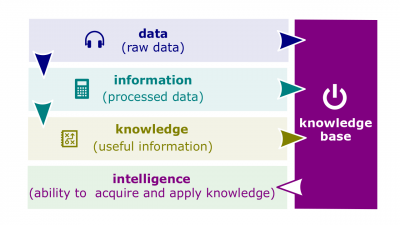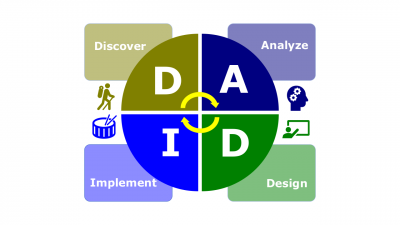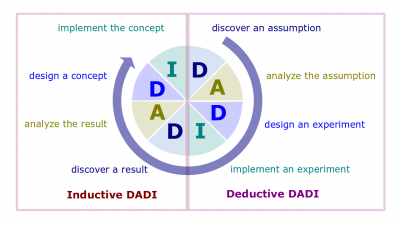Concept Management Quarter
Concept Management Quarter (hereinafter, the Quarter) is a lecture introducing the learners to portfolio planning primarily through key topics related to change management. The Quarter is the last of four lectures of Portfolio Quadrivium, which is the first of seven modules of Septem Artes Administrativi (hereinafter, the Course). The Course is designed to introduce the learners to general concepts in business administration, management, and organizational behavior.
Contents
Outline
Enterprise Architecture Quarter is the predecessor lecture. In the enterprise envisioning series, the previous lecture is Organizational Culture Quarter.
- Portfolio management is the enterprise planning of the enterprise portfolio. This lecture concentrates on iterative development because this development is the main technique to do that.
Concepts
- Concept management. Handling of concepts.
- Records management.
- Idea management. Handling of change ideas.
- Enterprise goal. A desired outcome towards which the enterprise effort is directed.
- Goal (objective). Desired outcome or target.
- Real goal. A goal that an organization actually pursues, as defined by the actions of its members.
- Means-end chain. An integrated network of goals in which the accomplishment of goals at one level serves as the means for achieving the goals, or ends, at the next level.
- Stated goal. An official statement of what an organization says, and what it wants its various stakeholders to believe, its goals are.
- Vision statement. A formal articulation of an organization's vision or mission.
- Business goal. A state or condition the business must satisfy to reach its vision.
- Business policy. A business policy is a non-actionable directive that supports a business goal.
- Business rule(s). A business rule is a specific, actionable, testable directive that is under the control of the business and supports a business policy.
- Business plan. A written document that interprets the strategic plan for enterprise stakeholders, for instance, financial or governmental institutions with regard to a business opportunity and articulation of how the identified opportunity is to be seized and exploited.
- Enterprise administration. Practice and a set of concepts, based on that practice, that define culture of administering all enterprise efforts from identifying business opportunities and up to getting of all enterprise outcomes and/or achieving enterprise impacts.
- Administration. The process or activity of running a business, organization, etc. or the officials who executive that process or activity.
- Management. The process or activity of dealing with or controlling things or people.
- Strategic management. What managers do to develop the enterprise's strategies, policies, and operative rules.
- Enterprise objective. A measureable step taken in order to achieve the enterprise goal.
- Objective. A target or metric that an individual, group, and/or enterprise seeks to meet in order to progress towards a goal.
- Strategic management process. A six-step process that encompasses strategic planning, implementation, and evaluation.
- Enterprise result. Any enterprise output, outcome, benefit, and/or drawback that effects somebody or something or may be perceived as effecting somebody or something.
- Enterprise output. Any permanent or temporary, tangible or intangible output that is directly created during an enterprise effort.
- Enterprise outcome. All consequences of the change derived from using the enterprise outputs.
- Enterprise benefit. The measurable improvement resulting from an enterprise administration that is perceived or may be perceived as an advantage by one or more stakeholders.
- Enterprise drawback. The measurable improvement resulting from an enterprise administration that is perceived or may be perceived as an disadvantage by one or more stakeholders.
- Business report. An account given of a particular business matter, especially in the form of an official document, after thorough investigation or consideration by an appointed person or body.
- Progress report. An account given of state of a project, operations, or other enterprise effort.
- Planning. Management function and administrative process that involves defining goals, setting objectives based on those goals, establishing strategies for achieving those objectives, and developing plans in order to integrate and coordinate those activities that would implement the strategies.
Breath of plan Portfolio Project Operations market exchangeable Solution Procurement Time frame Long-term plan Short-term plan Vary Specificity Directional plan Vary Specific plan Frequency of use Single-use plan Standing plan - Sprint plan. The tangible outcome of a Sprint planning meeting. The Sprint plan is a written document assembled by the development team and includes 1) the goal for the sprint—a brief description of the product or deliverable to be completed by the end of the sprint, and 2) a detailed list of the product backlog items (PBIs) or user stories the team has committed to completing by the end of the sprint, based on the team’s availability and velocity. Each PBI or user story is broken down into tasks according to the priority set by the product owner and assigned to a team member.
- Specific plan. A plan that is clearly defined and leaves no room for interpretation.
- Standing plan. An ongoing plan that provides guidance for activities performed repeatedly.
- Short-term plan. A plan covering one year or less.
- Single-use plan. A one-time plan specifically designed to meet the needs of a unique situation.
- Directional plan. A plan that is flexible and sets out general guidelines.
- Formal planning department. A group of planning specialists whose sole responsibility is helping to write organizational plans.
- Long-term plan. A plan with a time frame beyond three years.
- Release plan. The plan that outlines the features to be included in an upcoming release and provides an estimated date for the release. The plan should include responsibilities, resources, and activities required to complete the release.
- Procurement plan.
- Commercial off-the-shelf software (COTS software). Software developed and sold for a particular market.
- Make or buy (or build vs buy). The act of choosing between manufacturing a product in-house or purchasing it from an external supplier.
- Total cost of ownership.
- Risk management. A process of identifying what can go wrong and making plans that will enable a system to achieve its goals.
- Risk response plan. A document detailing identified risks, including description, cause, probability of occurring, impact(s) on objectives, proposed responses, owners, and current status. The proposed responses may utilize risk-response techniques such as avoidance, avoidance, avoidance, and acceptance that are designed to enhance opportunities and reduce threats to the project's objectives. The tools include .
- Contingency planning. The development of a management plan that identifies alternative strategies to be used to ensure project success if specified risk events occur.
- Workaround. A response to a negative risk event. Distinguished from contingency plan in that a workaround is not planned in advance of the occurrence of the risk event.
- Knowledge management. Handling of enterprise information.
- Knowledge. (1) Facts, information, and skills acquired by a legal entity through experience or learning; (2) The theoretical or practical understanding of a subject; (3) Awareness or familiarity gained by experience of a fact or situation.
- Strategic flexibility. The ability to recognize major external changes, to quickly commit resources, and to recognize when a strategic decision was a mistake.
- Continuous improvement. A process of improving quality and efficiency by making small, incremental changes over time. In Kanban, continuous improvement refers specifically to the process of optimizing workflow and reducing cycle time, resulting in increased productivity.
- Requirements management. The activities that control requirements development, including requirements change control, requirements attributes definition, and requirements traceability.
- Requirements risk mitigation strategy. An analysis of requirements-related risks that ranks risks and identifies actions to avoid or minimize those risks.
- Kaizen. In Japanese, the word means "improvement". This is the philosophy of continuous process improvement using analytical tools and methods.
- Paradox theory. The theory that the key paradox in enterprise administration is that there is no final status for an enterprise.
Roles
- Top manager. A manager at or near the upper levels of the organizational structure who are responsible for making organization-wide decisions and establishing the goals and plans that affect the entire organization.
- Chief executive. An individual who determines and formulates policies and provides overall direction of enterprises within guidelines set up by a board of directors or similar governing body. He or she plans, directs, or coordinates operational activities at the highest level of management with the help of subordinate executives and staff managers.
- Board of directors. A group of influential individuals, elected by stockholders, chosen to over see the affairs of a company. A board typically includes investors and mentors. Not all startups have a board, but investors typically require a board seat in exchange for an investment in a company.
- Document management specialist. A professional who implements and administers enterprise-wide document management systems and related procedures that allow enterprises to capture, store, retrieve, share, and destroy electronic records and documents.
Methods
- Management method.
- PDCA (Plan-Do-Check-Act Cycle). An iterative four-step management method created by W. Edwards Deming.
- OODA loop.
- DREPD (or DREPD cycle). The enterprise development pattern that divides enterprise administration in four batches: Discovery (D), Research (R), Envisioning (E), and Planning (P). Although the batches tend to be both consecutive and complete, this statement is rarely true. Most frequently, Discovery can occur at any time and the newly discovered data re-starts the process.
- Deductive DREPD.
- Inductive DREPD.
- Viable DREPD. A pattern that consists of both Deductive DREPD and Inductive DREPD.
- Collaborating, learning and adapting (CLA). A method employed in adaptive management that suggests a specific sequence of designing, implementing, adapting, and evaluating programs conducted in uncertain environments.
- Adaptive collaboration. Collaborating intentionally with stakeholders in order to extensively monitor the environment, to share knowledge, and to reduce duplication of effort.
- Adaptive monitoring. Systematic acquiring data of results and factors emerged in the environment, learning systematically by drawing on evidence from a variety of sources, and taking the time to reflect on implementation.
- Continuous adoption. Making quick adjustments to the newly-discovered factors based on applied learning.
- Three-stage model of creativity. The proposition that creativity involves three stages: causes (creative potential and creative environment), creative behavior, and creative outcomes (innovation).
Instruments
- Document management system.
- Knowledge management system. Any system, tangible or software, that stores and retrieves knowledge, improves collaboration, locates knowledge sources, mines repositories for hidden knowledge, captures and uses knowledge, or in some other way enhances the knowledge management process.
- MediaWiki. The most popular open-source wiki engine that runs on many websites, including Wikipedia and this very website. This software is written in the PHP programming language and stores the contents into a database.
Results
- Strategic plan. A plan that applies to the entire enterprise, formalizes its enterprise portfolio, and establishes the enterprise's overall goals. This plan also defines its business models and may or may not include related competitive strategies.
- Strategy. A plan of action and/or policy designed to achieve a major or overall aim.
- Commitment concept. Plans should extend for enough to meet those commitments made when the plans were developed.
- Roadmap. A strategic plan to create a product or complete a project. A roadmap describes the individual steps required to meet a set of goals or objectives.
Practices
- Some practitioners believe that business plans have no value for the business itself.
Indeed, it is impossible or almost impossible to predict revenues with no historical data. Furthermore, every bank asks about a business plan, but no real bank provides a business with external funding based on a business plan alone. Taking into consideration these observations, business plans may be considered as documents that banks need in order to report to the government and to use in their public relations that the banks support business.No business plan survives first contact with customers -- Steve Blank, entrepreneur
Validated Learning Quarter is the successor lecture. In the enterprise planning series, the next lecture is Project Management Quarter.


